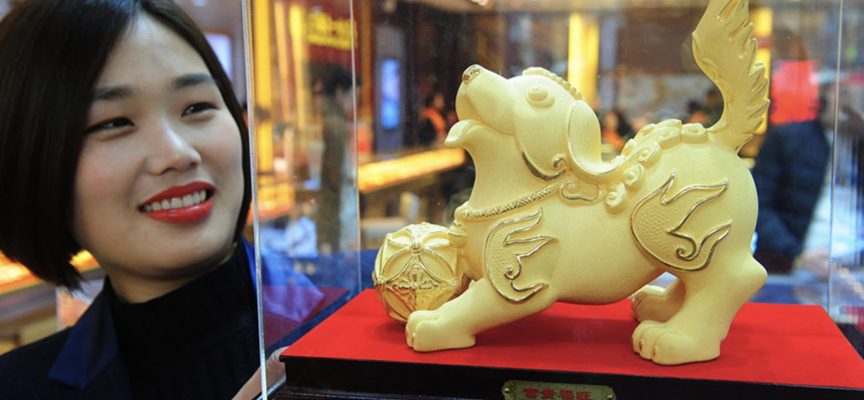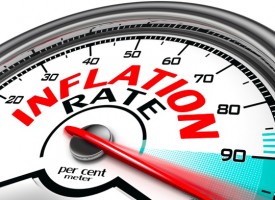Apparently “China may have 30,000 tonnes of gold” as gold reenters the global monetary system.
New Monetary System Backed By Gold
April 7 (King World News) – Dr. Stephen Leeb: Over the past several years, especially since early 2016, the gold market has been stuck in a trading range. The price has been low $1,100’s to high $1,300’s – or about a 25 percent range. I admit that I expected more. Call me impatient but do not call me wrong. Over the past several years one event after another have made it utterly clear that we are on a relentless road to a new monetary system backed by gold…
Gold is making its way back into the global monetary
system, to learn more CLICK HERE!
 Sponsored
Sponsored
Even the quiet trading range can be seen as masking the seismic, yet largely hidden events, related to gold. The trading range for gold denominated by Chinese yuan is a remarkably low 8 percent since mid-2016. As I have said in previous interviews, gold flat-lining in terms of the yuan hides coming changes while reinforcing a major change which draws ever nearer. Yuan trading in oil and other commodities is trading that is de facto backed by gold in that any party receiving yuan can exchange that yuan for gold. And in those zones where this trading takes place gold can be exported to other countries. The ultra-tight trading range continues to evidence that the yuan is as good as gold.

Central Bank Buying Of Gold Highest Since Nixon
I am not going to take a position on whether these trading ranges are the result of central bank intervention or – at least in the case of the yuan denominated gold – arbitrage. But these ranges start to look a bit suspicious when you consider that central bank buying of gold has reached the highest level since Nixon took us off the gold standard in 1971 at over 650 tonnes, an increase of more than 70% from 2017.
Moreover, for practical purposes that number is likely vastly underestimated as it does not fully reflect China’s gold accumulation. According to figures released by China, the People’s Bank of China (PBOC) accumulated very little gold – about 11 tonnes. However, as I have stated before, credible analysts believe China has been accumulating gold at the rate of about 1,500 or more tonnes a year over at least the past ten years. My feeling until very recently is that the PBOC was deliberately understating its rate of gold accumulation so as not to spark panic buying.
China’s 30,000 Tonne Gold Hoard
I now believe that there may be very little difference between gold held by the PBOC and gold held by China’s large banks. Indeed, if seasoned analysts such as Simon Hunt, who, at Wood Mackenzie, headed one of the world’s top gold analytic teams can be believed, China may have 30,000 tonnes of gold. More than half that gold is likely at major banks and the PBOC. The division between the PBOC and other banks may not be that important. A singularly important sub rosa happening explains why.

Though it may be a bit painful, go back to 2013. Gold entered the year trading in the mid-to-high $1,600’s. Many, including myself, felt the metal was consolidating after making an all-time nominal high of over $1,900 toward the end of 2011. A major tailwind for gold at that time was the expectation that the Bank for International Settlements (BIS) Basel III regulations would give gold a 100% weight as a liquidity buffer on banks’ balance sheets. That would have made gold as good as cash for assessing offsets to risk and incentivized the holding of gold by both central banks and individual banks. To make a sad story a short one, it did not work out that way. To make the sad story even sadder, when Cyprus got into financial difficulties the IMF suggested the country sell gold reserves to boost capital – making it utterly clear that BIS was not ready to anoint gold as a 100 percent risk offset…
BONUS INTERVIEW:
To listen to Doug Casey’s KWN interview discussing his prediction of financial and economic chaos and a panic into gold CLICK HERE OR BELOW:
Gold promptly entered a full-fledged correction, which did not end until the December of 2015 when the yellow metal briefly traded below $1,050. Admittedly, with the caveat that BIS can always change regulations, as of March 29th, the date the latest version of Basal III went into effect, gold is a 100 percent liquidity buffer.
Prelude To Gold’s Entry Into The Monetary System
So why has the world just yawned at this change? One reason is that it has not been widely advertised. Another could be central banks’ desire to keep gold in a trading range. Banks keeping gold in a trading range is not necessarily conspiratorial thinking in that the eventual outcome could be a trading range for gold at a much higher level. Central banks could reasonably argue that by maintaining a trading range they are preparing the world for gold’s entry into the monetary system.
Each month the BIS publishes a long paper – 150 or more pages of mostly highly technical details about banking finance and risk control. Probably more due to luck than skill I found the following paragraph in the December 2017 paper, which was titled “Finalising post-crisis reforms.” To be precise the paragraph was number 96 in the first section of the paper. It read:
“A 0% risk weight will apply to (i) cash owned and held at the bank or in transit; and (ii) gold bullion held at the bank or held in another bank on an allocated basis, to the extent the gold bullion assets are backed by bullion liabilities.”
Even that single sentence was challenging to interpret, at least for me. At first I thought the last phrase, viz., “to the extent………” modified all of (ii), but it doesn’t. It only modifies the part referring to gold that is allocated to the bank and means until the gold is delivered the bank must carry liabilities sufficient to pay in full for the gold…
ALERT:
Mining legend Ross Beaty (Chairman Pan American Silver) is investing in a company very few people know about. To find out which company CLICK HERE OR ON THE IMAGE BELOW.
 Sponsored
Sponsored
The bottom line is that BIS, which is often referred to as the central bank of central banks, has issued guidelines that equate gold and cash as a risk or liquidity buffer. To explain why this is so important, realize that any asset on a bank’s balance sheet is assigned a risk weighting ranging from O to sometimes over 100 in the case of problematic loans. Each asset is multiplied by its risk weighting and the results are then summed. BIS guidelines suggest that the bank’s common “core” equity (surplus cash, common shares, and other items that get full weight in defining a bank’s net worth) should be at least 4.5% to 6% of the sum of risk weighted assets.
This means that if a bank makes a loan and the loan has a 50% risk weighting, the bank’s ratio of core equity to risk-weighted assets will go down. One way of keeping the ratio stable would be to sell assets for either cash or gold. From a long-term perspective gold is much better than cash. A 1925 dollar is worth $.07 today, while gold has appreciated substantially, outperforming the dollar by 65-fold.
This explains the urgent buying of gold by central banks, but also explains why the PBOC may not be holding a lot more gold than it says. The PBOC could have acquired gold on behalf of its commercial banks, and those banks could hold massive amounts of gold on their balance sheets. When gold is revalued, which is inevitable, those banks will be far and away the strongest banks in the world. And indeed, the entire Chinese economy will be sitting on extremely strong footing…
BONUS INTERVIEW:
Mag Silver Co-Founder says this company may have just found the
source of Arizona Mining’s massive $1.3 billion Taylor
Deposit CLICK HERE OR BELOW:
April 1st was the tenth anniversary of the publication of a fairly brief paper published by BIS and authored by the then head of the PBOC, Zhou Xiaochuan. The paper argued for a new monetary system that would be based on SDRs. One statement in it stands out:
“The basket of currencies forming the basis for SDR valuation should … include currencies of all major economies … the SDR can be shifted from a purely calculation-based system to a system backed by real assets…”
Zhou shrewdly does not mention gold, but clearly since all major real assets other than gold are primarily used by industry and cannot be fixed in price, gold is the only asset that fits the bill.
$10,000+ Gold
I have argued for some time that the new monetary system will be based on blockchains of gold-backed SDRs. The light at the end of this epic tunnel is gleaming inexorably brighter. Given the amount of gold in the world available as a reserve pool to back up SDRs and the amount of yearly trade and total debt, the kind of monetary system I envision will eventually mean a gold price well above $10,000. My guess is that gold will see step-wise revaluations with each revaluation followed by a trading range. In other words gold’s price will be managed much like short-term interest rates in the US. And the Federal Reserve Board will take a back seat to a new regulatory body, perhaps dubbed the World Gold Reserve Board.
***KWN has now released the powerful KWN audio interview with Egon von Greyerz and you can listen to it by CLICKING HERE OR ON THE IMAGE BELOW.
***Also just released: ALERT: Commercials Cover Large Number Of Silver Shorts! Also Cover Gold Shorts CLICK HERE TO READ.
 © 2019 by King World News®. All Rights Reserved. This material may not be published, broadcast, rewritten, or redistributed. However, linking directly to the articles is permitted and encouraged.
© 2019 by King World News®. All Rights Reserved. This material may not be published, broadcast, rewritten, or redistributed. However, linking directly to the articles is permitted and encouraged.









